Posts tagged first
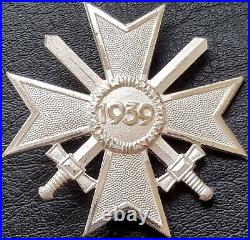
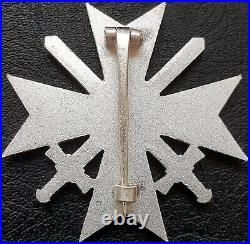
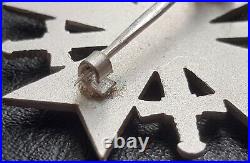
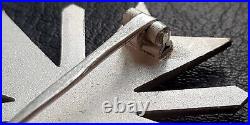
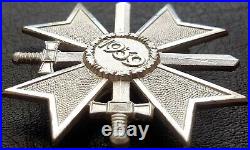
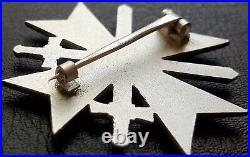
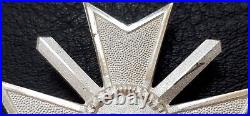
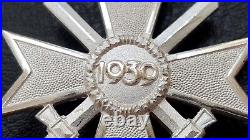
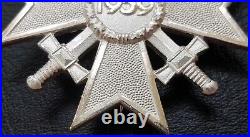
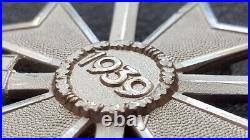
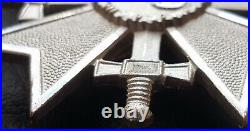
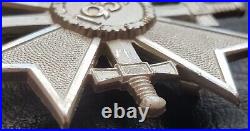
Original German post WW2 / 1957 pattern War Merit Cross First Class (Kriegsverdienstkreuz), IN VERY NICE CONDITION WITH PERFECT PIN DEVICE, ST&L (STEINHAUER & LUECK) MADE EXAMPLE LATER WITH OPEN HINGE BLOCK, A REALLY GOOD PIECE. FEW FACTS ABOUT THE GERMAN 1957 PATTERN AWARDS. In 1957 the West German government authorised replacement Iron Crosses with an Oak Leaf Cluster in place of the swastika, similar to the Iron Crosses of 1813, 1870, and 1914, which could be worn by World War II Iron Cross recipients. The 1957 law also authorised de-Nazified versions of most other World War II-era decorations (except those specifically associated with Nazi Party organizations, such as SS Long Service medals, or with the expansion of the German Reich, such as the medals for the annexation of Austria, the Sudetenland, and the Memel region). The main government contract to manufacture and supply these new de-nazified WW2 1957 official decorations went to the world famous German firm Steinhauer & Lueck, Luedenscheid Germany. Knights Crosses, Iron Crosses, Wound Badges, Tank Assault Badges etc were re-designed by Steinhauer & Lück – often with the oak-leaf spray replacing the swastika, with S&L having the sole patent rights to all WW2 1957 German decorations. S&L did not have the whole monopoly on medal making, other famous firms such as Deschler & Sohn, BH Maher and Juncker also manufactured these new German decorations. Lüdenscheid is situated between the cities Dortmund and Bonn. It was here that one of the youngest medal firms was founded in 1889 by August Steinhauer and Gustav Adolf Lück. The first production began in a cellar, the customer base continued to increase. A property was bought at 51 Hochstrasse which is still home for this famous company today. During WW2 Steinhauer & Lück produced medals and badges, like the famous Knights Cross and many other types of medals and badges. In 1957 this company was awarded the contract to produce all the newly re-designed legal WW2 1957 de-nazified decorations, plus the contract to manufacture all of Germany’s official decorations including Germany’s highest order the Bundesverdienstkreuz. Only a very limited number of original WW2 1957 medals are still produced, mainly Iron Crosses, German Cross Gold & Silver & Wound Badges and are considered 100% genuine by the German Government. HISTORY OF THE AWARD. The War Merit Cross (Kriegsverdienstkreuz) and War Merit Medal (Kriegsverdienstmedaille) was a decoration of Nazi Germany during the Second World War, which could be awarded to civilians as well as military personnel. It was reissued in 1957 by the Bundeswehr in a De-Nazified version for veterans. This award was created by Adolf Hitler in 1939 as a successor to the non-combatant Iron Cross which was used in earlier wars (same medal but with a different ribbon). The award was graded the same as the Iron Cross: War Merit Cross Second Class, War Merit Cross First Class, and Knights Cross of the War Merit Cross. The award had two variants: with swords given to soldiers for exceptional service in battle above and beyond the call of duty (but not worthy of an Iron Cross which was more a bravery award), and without swords for meritorious service behind the lines which could also be awarded to civilians. Recipients had to have the lower grade of the award before getting the next level. There was also another version below the 2nd class simply called the War Merit Medal (German: Kriegsverdienstmedaille), set up in 1940 for civilians in order to offset the large number of 2nd class without swords being awarded. It was usually given to those workers in factories who significantly exceeded work quotas. One notable winner of the War Merit Cross was William Joyce (aka Lord Haw-Haw) who received both the second and first class, both without swords. Recipients of the Knights Cross of the War Merit Cross customarily received the medal from holders of the Knights Cross of the Iron Cross, to symbolize the link between the combat soldier and their supporters, who helped maintain the war effort. There was one extra grade of the War Merit Cross, which was created at the suggestion of Albert Speer: The Knights Cross of the War Merit Cross in Gold, but this was never officially placed on the list of national awards as it came about in 1945 and there was no time to officially promulgate the award before the war ended. The Knights Cross of the War Merit Cross in Gold (without swords) was awarded’on paper’ to two recipients on 20 April 1945: Franz Hahne and Karl-Otto Saur. The ribbon of the War Merit Cross was in red-white-black-white-red; that was, the red and black colors being reversed from the ribbon of the World War II version of the Iron Cross. The ribbon for the War Merit Medal was similar, but with a narrow red vertical red strip in the center of the black field. Soldiers who earned the War Merit Cross 2nd Class with Swords wore a small crossed-swords device on the ribbon. The War Merit Cross 1st Class was a pin-backed medal worn on the pocket of the tunic (like the Iron Cross 1st Class). The ribbon of the War Merit Cross 2nd Class could be worn like the ribbon of the Iron Cross 2nd Class (through the third buttonhole). Combat soldiers tended to hold the War Merit Cross in low regard, referring to its wearers as being in’Iron Cross Training’, and prior to 28 September 1941, the War Merit Cross could not be worn with a corresponding grade of the Iron Cross, which took precedence. A total of 118 awards of the Knights Cross of the War Merit Cross with swords, and 137 awards of the Knights Cross of the War Merit Cross without swords were awarded. Considering the relative rarity of the award compared with the grades of the Knights Cross of the Iron Cross, it took on extra meaning. For example, Reichsmarschall Hermann Göring made a concerted effort to get Hitler to award him this order, much to Hitler’s annoyance. In response, Hitler outlined a series of criteria governing the awarding of this decoration and the philosophy of such awards, and directed that “prominent party comrades” were not to be awarded with the Knights Cross of the War Merit Cross (or similar decorations), and withdrew the proposed awards of this order to Gauleiter Erich Koch and State Secretary Karl Hanke. Directing his comments at Göring personally, Hitler ordered that such attempts to gain this award be stopped (from a letter dated 27 August 1943 from Führerhauptquartier). Also, the scarcity of the award of the Knights Cross of the War Merit Cross compared with the Kinghts Cross of the Iron Cross gave it an “air of exclusiveness” it did not really deserve, as it ranked below the Knights Cross of the Iron Cross. Six persons received two Knights Cross’ of the War Merit Cross (one with Swords and one without Swords): Walter Brugmann, Julius Dorpmuller, Karl-Otto Saur, Albin Sawatzki, Walter Schreiber, and Walter Rohlandt.
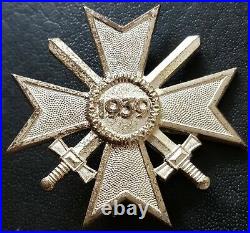
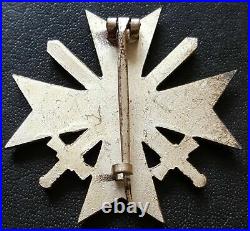
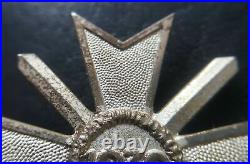
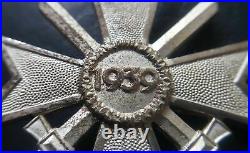
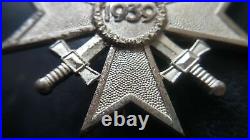
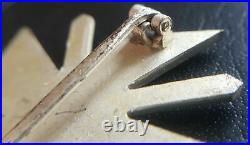
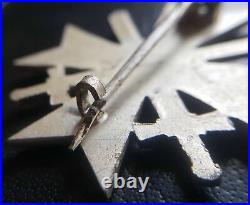
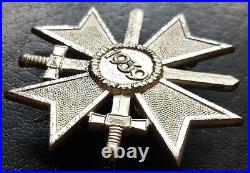
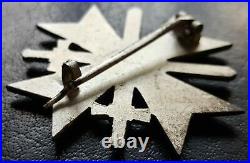
Original German War Merit Cross First Class Kriegsverdienstkreuz / post WW2 version (1957 pattern) – no swastika, VERY NICE CONDITION – WORKING PIN DEVICE, EARLY PERIOD ST&L (STEINHAUER & LUECK) MADE EXAMPLE – REALLY GOOD PIECE FROM THE 60′S (SOLID HINGE BLOCK). In 1957 the West German government authorised replacement Iron Crosses with an Oak Leaf Cluster in place of the swastika, similar to the Iron Crosses of 1813, 1870, and 1914, which could be worn by World War II Iron Cross recipients. The 1957 law also authorised de-Nazified versions of most other World War II-era decorations (except those specifically associated with Nazi Party organizations, such as SS Long Service medals, or with the expansion of the German Reich, such as the medals for the annexation of Austria, the Sudetenland, and the Memel region). The main government contract to manufacture and supply these new de-nazified WW2 1957 official decorations went to the world famous German firm Steinhauer & Lueck, Luedenscheid Germany. Knights Crosses, Iron Crosses, Wound Badges, Tank Assault Badges etc were re-designed by Steinhauer & Lück – often with the oak-leaf spray replacing the swastika, with S&L having the sole patent rights to all WW2 1957 German decorations. S&L did not have the whole monopoly on medal making, other famous firms such as Deschler & Sohn, BH Maher and Juncker also manufactured these new German decorations. Lüdenscheid is situated between the cities Dortmund and Bonn. It was here that one of the youngest medal firms was founded in 1889 by August Steinhauer and Gustav Adolf Lück. The first production began in a cellar, the customer base continued to increase. A property was bought at 51 Hochstrasse which is still home for this famous company today. During WW2 Steinhauer & Lück produced medals and badges, like the famous Knights Cross and many other types of medals and badges. In 1957 this company was awarded the contract to produce all the newly re-designed legal WW2 1957 de-nazified decorations, plus the contract to manufacture all of Germany’s official decorations including Germany’s highest order the Bundesverdienstkreuz. Only a very limited number of original WW2 1957 medals are still produced, mainly Iron Crosses, German Cross Gold & Silver & Wound Badges and are considered 100% genuine by the German Government. HISTORY OF THE AWARD. The War Merit Cross (Kriegsverdienstkreuz) and War Merit Medal (Kriegsverdienstmedaille) was a decoration of Nazi Germany during the Second World War, which could be awarded to civilians as well as military personnel. It was reissued in 1957 by the Bundeswehr in a De-Nazified version for veterans. This award was created by Adolf Hitler in 1939 as a successor to the non-combatant Iron Cross which was used in earlier wars (same medal but with a different ribbon). The award was graded the same as the Iron Cross: War Merit Cross Second Class, War Merit Cross First Class, and Knights Cross of the War Merit Cross. The award had two variants: with swords given to soldiers for exceptional service in battle above and beyond the call of duty (but not worthy of an Iron Cross which was more a bravery award), and without swords for meritorious service behind the lines which could also be awarded to civilians. Recipients had to have the lower grade of the award before getting the next level. There was also another version below the 2nd class simply called the War Merit Medal (German: Kriegsverdienstmedaille), set up in 1940 for civilians in order to offset the large number of 2nd class without swords being awarded. It was usually given to those workers in factories who significantly exceeded work quotas. One notable winner of the War Merit Cross was William Joyce (aka Lord Haw-Haw) who received both the second and first class, both without swords. Recipients of the Knights Cross of the War Merit Cross customarily received the medal from holders of the Knights Cross of the Iron Cross, to symbolize the link between the combat soldier and their supporters, who helped maintain the war effort. There was one extra grade of the War Merit Cross, which was created at the suggestion of Albert Speer: The Knights Cross of the War Merit Cross in Gold, but this was never officially placed on the list of national awards as it came about in 1945 and there was no time to officially promulgate the award before the war ended. The Knights Cross of the War Merit Cross in Gold (without swords) was awarded’on paper’ to two recipients on 20 April 1945: Franz Hahne and Karl-Otto Saur. The ribbon of the War Merit Cross was in red-white-black-white-red; that was, the red and black colors being reversed from the ribbon of the World War II version of the Iron Cross. The ribbon for the War Merit Medal was similar, but with a narrow red vertical red strip in the center of the black field. Soldiers who earned the War Merit Cross 2nd Class with Swords wore a small crossed-swords device on the ribbon. The War Merit Cross 1st Class was a pin-backed medal worn on the pocket of the tunic (like the Iron Cross 1st Class). The ribbon of the War Merit Cross 2nd Class could be worn like the ribbon of the Iron Cross 2nd Class (through the third buttonhole). Combat soldiers tended to hold the War Merit Cross in low regard, referring to its wearers as being in’Iron Cross Training’, and prior to 28 September 1941, the War Merit Cross could not be worn with a corresponding grade of the Iron Cross, which took precedence. A total of 118 awards of the Knights Cross of the War Merit Cross with swords, and 137 awards of the Knights Cross of the War Merit Cross without swords were awarded. Considering the relative rarity of the award compared with the grades of the Knights Cross of the Iron Cross, it took on extra meaning. For example, Reichsmarschall Hermann Göring made a concerted effort to get Hitler to award him this order, much to Hitler’s annoyance. In response, Hitler outlined a series of criteria governing the awarding of this decoration and the philosophy of such awards, and directed that “prominent party comrades” were not to be awarded with the Knights Cross of the War Merit Cross (or similar decorations), and withdrew the proposed awards of this order to Gauleiter Erich Koch and State Secretary Karl Hanke. Directing his comments at Göring personally, Hitler ordered that such attempts to gain this award be stopped (from a letter dated 27 August 1943 from Führerhauptquartier). Also, the scarcity of the award of the Knights Cross of the War Merit Cross compared with the Kinghts Cross of the Iron Cross gave it an “air of exclusiveness” it did not really deserve, as it ranked below the Knights Cross of the Iron Cross. Six persons received two Knights Cross’ of the War Merit Cross (one with Swords and one without Swords): Walter Brugmann, Julius Dorpmuller, Karl-Otto Saur, Albin Sawatzki, Walter Schreiber, and Walter Rohlandt. This item is in the category “Collectables\Militaria\World War II (1939-1945)\Medals/ Ribbons”. The seller is “a..anderson” and is located in this country: GB. This item can be shipped worldwide.
- Era: 1945-Present
- Country/ Organization: Germany
- Country/Region of Manufacture: Germany
- Theme: Militaria
- Conflict: World War II (1939-1945)
- Service: Army
- Type: Medals & Ribbons
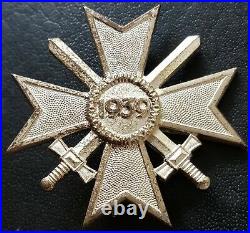
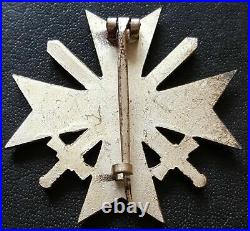
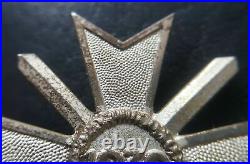
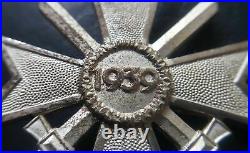
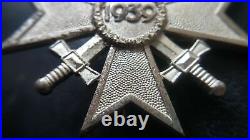
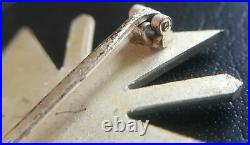
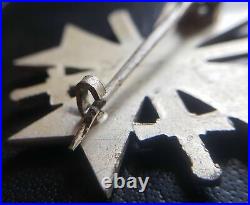
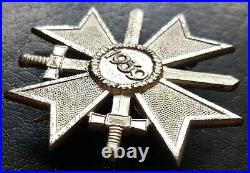
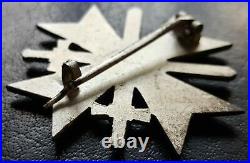
Original German War Merit Cross First Class Kriegsverdienstkreuz / post WW2 version (1957 pattern) – no swastika, VERY NICE CONDITION – WORKING PIN DEVICE, EARLY PERIOD ST&L (STEINHAUER & LUECK) MADE EXAMPLE – REALLY GOOD PIECE FROM THE 60′S (SOLID HINGE BLOCK). In 1957 the West German government authorised replacement Iron Crosses with an Oak Leaf Cluster in place of the swastika, similar to the Iron Crosses of 1813, 1870, and 1914, which could be worn by World War II Iron Cross recipients. The 1957 law also authorised de-Nazified versions of most other World War II-era decorations (except those specifically associated with Nazi Party organizations, such as SS Long Service medals, or with the expansion of the German Reich, such as the medals for the annexation of Austria, the Sudetenland, and the Memel region). The main government contract to manufacture and supply these new de-nazified WW2 1957 official decorations went to the world famous German firm Steinhauer & Lueck, Luedenscheid Germany. Knights Crosses, Iron Crosses, Wound Badges, Tank Assault Badges etc were re-designed by Steinhauer & Lück – often with the oak-leaf spray replacing the swastika, with S&L having the sole patent rights to all WW2 1957 German decorations. S&L did not have the whole monopoly on medal making, other famous firms such as Deschler & Sohn, BH Maher and Juncker also manufactured these new German decorations. Lüdenscheid is situated between the cities Dortmund and Bonn. It was here that one of the youngest medal firms was founded in 1889 by August Steinhauer and Gustav Adolf Lück. The first production began in a cellar, the customer base continued to increase. A property was bought at 51 Hochstrasse which is still home for this famous company today. During WW2 Steinhauer & Lück produced medals and badges, like the famous Knights Cross and many other types of medals and badges. In 1957 this company was awarded the contract to produce all the newly re-designed legal WW2 1957 de-nazified decorations, plus the contract to manufacture all of Germany’s official decorations including Germany’s highest order the Bundesverdienstkreuz. Only a very limited number of original WW2 1957 medals are still produced, mainly Iron Crosses, German Cross Gold & Silver & Wound Badges and are considered 100% genuine by the German Government. HISTORY OF THE AWARD. The War Merit Cross (Kriegsverdienstkreuz) and War Merit Medal (Kriegsverdienstmedaille) was a decoration of Nazi Germany during the Second World War, which could be awarded to civilians as well as military personnel. It was reissued in 1957 by the Bundeswehr in a De-Nazified version for veterans. This award was created by Adolf Hitler in 1939 as a successor to the non-combatant Iron Cross which was used in earlier wars (same medal but with a different ribbon). The award was graded the same as the Iron Cross: War Merit Cross Second Class, War Merit Cross First Class, and Knights Cross of the War Merit Cross. The award had two variants: with swords given to soldiers for exceptional service in battle above and beyond the call of duty (but not worthy of an Iron Cross which was more a bravery award), and without swords for meritorious service behind the lines which could also be awarded to civilians. Recipients had to have the lower grade of the award before getting the next level. There was also another version below the 2nd class simply called the War Merit Medal (German: Kriegsverdienstmedaille), set up in 1940 for civilians in order to offset the large number of 2nd class without swords being awarded. It was usually given to those workers in factories who significantly exceeded work quotas. One notable winner of the War Merit Cross was William Joyce (aka Lord Haw-Haw) who received both the second and first class, both without swords. Recipients of the Knights Cross of the War Merit Cross customarily received the medal from holders of the Knights Cross of the Iron Cross, to symbolize the link between the combat soldier and their supporters, who helped maintain the war effort. There was one extra grade of the War Merit Cross, which was created at the suggestion of Albert Speer: The Knights Cross of the War Merit Cross in Gold, but this was never officially placed on the list of national awards as it came about in 1945 and there was no time to officially promulgate the award before the war ended. The Knights Cross of the War Merit Cross in Gold (without swords) was awarded’on paper’ to two recipients on 20 April 1945: Franz Hahne and Karl-Otto Saur. The ribbon of the War Merit Cross was in red-white-black-white-red; that was, the red and black colors being reversed from the ribbon of the World War II version of the Iron Cross. The ribbon for the War Merit Medal was similar, but with a narrow red vertical red strip in the center of the black field. Soldiers who earned the War Merit Cross 2nd Class with Swords wore a small crossed-swords device on the ribbon. The War Merit Cross 1st Class was a pin-backed medal worn on the pocket of the tunic (like the Iron Cross 1st Class). The ribbon of the War Merit Cross 2nd Class could be worn like the ribbon of the Iron Cross 2nd Class (through the third buttonhole). Combat soldiers tended to hold the War Merit Cross in low regard, referring to its wearers as being in’Iron Cross Training’, and prior to 28 September 1941, the War Merit Cross could not be worn with a corresponding grade of the Iron Cross, which took precedence. A total of 118 awards of the Knights Cross of the War Merit Cross with swords, and 137 awards of the Knights Cross of the War Merit Cross without swords were awarded. Considering the relative rarity of the award compared with the grades of the Knights Cross of the Iron Cross, it took on extra meaning. For example, Reichsmarschall Hermann Göring made a concerted effort to get Hitler to award him this order, much to Hitler’s annoyance. In response, Hitler outlined a series of criteria governing the awarding of this decoration and the philosophy of such awards, and directed that “prominent party comrades” were not to be awarded with the Knights Cross of the War Merit Cross (or similar decorations), and withdrew the proposed awards of this order to Gauleiter Erich Koch and State Secretary Karl Hanke. Directing his comments at Göring personally, Hitler ordered that such attempts to gain this award be stopped (from a letter dated 27 August 1943 from Führerhauptquartier). Also, the scarcity of the award of the Knights Cross of the War Merit Cross compared with the Kinghts Cross of the Iron Cross gave it an “air of exclusiveness” it did not really deserve, as it ranked below the Knights Cross of the Iron Cross. Six persons received two Knights Cross’ of the War Merit Cross (one with Swords and one without Swords): Walter Brugmann, Julius Dorpmuller, Karl-Otto Saur, Albin Sawatzki, Walter Schreiber, and Walter Rohlandt. This item is in the category “Collectables\Militaria\World War II (1939-1945)\Medals/ Ribbons”. The seller is “a..anderson” and is located in this country: GB. This item can be shipped worldwide.
- Era: 1945-Present
- Country/ Organization: Germany
- Country/Region of Manufacture: Germany
- Theme: Militaria
- Conflict: World War II (1939-1945)
- Service: Army
- Type: Medals & Ribbons
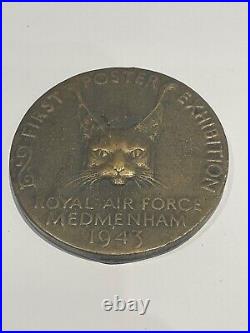
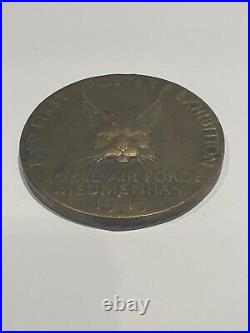
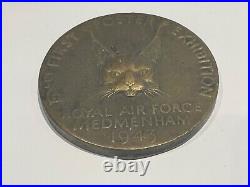
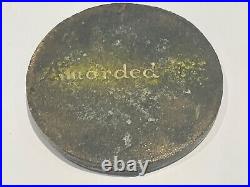
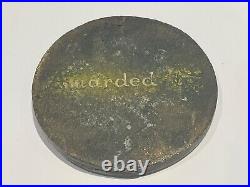
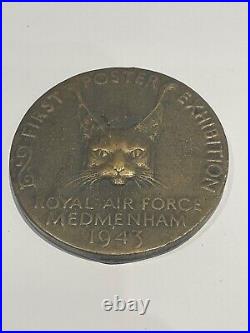
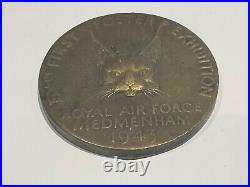
Offered here is a RARE piece of Militaria from the Royal Air Force from the period of The Second World War. We are unable to find out any information on the medal or medallion, however it is made from Cast Bronze. On the reverse it reads Awarded to. I cannot see if there is a worn name on the plaque or if it is blank, it is difficult to tell because of the brain in the casting. It is obviously an RAF piece from Medmenhan, and is a Bronze medal, Medallion or plaque. I cannot find anything from 1943 that explains what the First Poster Exhibition was. The medallion has a CAT design in the centre. The piece is heavy and thick and measures 3 inches (78 millimetres) across its diameter, it is 1/4 of an inch thick. If anyone does have any more information, please let me know what this represents, it is certainly a Rare piece. This is in nice condition with a lovely patina. It has been well cast from solid Bronze. RAF Medmenham is a former Royal Air Force station based at Danesfield House near Medmenham, Buckinghamshire Activities there specialised in Photographic Intelligence and it was once the home of the RAF Intelligence Branch During the Second World War, RAF Medmenham was the main interpretation centre for photographic reconnaissance operations in the European and Mediterranean theatres. April 1941, an RAF photographic interpretation unit (PIU) moved to Danesfield House, Medmenham, as its previous location at Wembley was short of space, and was renamed the Central Interpretation Unit (CIU). Later that year the Bomber Command Damage Assessment Section was absorbed, and amalgamation was completed when the Night Photographic Interpretation Section of No 3 Photographic Reconnaissance Unit, RAF Oakington was integrated with CIU in February 1942 and the base was assigned the motto Serve and Support. During 1942 and 1943, the CIU gradually expanded and was involved in the planning stages of practically every operation of the war, and in every aspect of intelligence. In 1945, daily intake of material averaged 25,000 negatives and 60,000 prints. The print library, which documented and stored worldwide cover, held 5,000,000 prints from which 40,000 reports had been produced. This item is in the category “Collectables\Militaria\World War II (1939-1945)\Medals/ Ribbons”. The seller is “quirkyvintageandbooks” and is located in this country: GB. This item can be shipped to United Kingdom, Antigua and Barbuda, Austria, Belgium, Bulgaria, Republic of Croatia, Cyprus, Czech Republic, Denmark, Estonia, Finland, France, Germany, Greece, Hungary, Ireland, Italy, Latvia, Lithuania, Luxembourg, Malta, Netherlands, Poland, Portugal, Romania, Slovakia, Slovenia, Spain, Sweden, Australia, United States, Bahrain, Canada, Japan, New Zealand, China, Israel, Hong Kong, Norway, Indonesia, Malaysia, Mexico, Singapore, South Korea, Switzerland, Taiwan, Bangladesh, Belize, Bermuda, Bolivia, Barbados, Brunei Darussalam, Cayman Islands, Dominica, Egypt, Guernsey, Gibraltar, Guadeloupe, Grenada, French Guiana, Iceland, Jersey, Jordan, Cambodia, Saint Kitts-Nevis, Saint Lucia, Liechtenstein, Sri Lanka, Macau, Monaco, Maldives, Montserrat, Martinique, Nicaragua, Oman, Pakistan, Paraguay, Reunion, Turks and Caicos Islands, Aruba, Saudi Arabia, South Africa, United Arab Emirates, Chile, Bahamas, Colombia, Costa Rica, Guatemala, Honduras, Jamaica, Kuwait, Panama, Philippines, Qatar, Trinidad and Tobago.
- Type: Medals & Ribbons
- Modification Description: It has been stamped Awarded to …. On the back
- Issued/ Not-Issued: Issued
- Era: 1914-1945
- Conflict: World War II (1939-1945)
- Country/ Organization: Great Britain
- Service: Air Force
- Theme: Militaria
- Country/Region of Manufacture: United Kingdom
- Modified Item: Yes
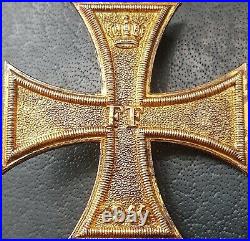
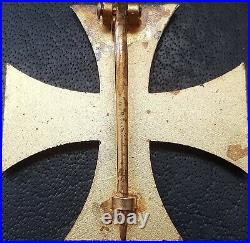
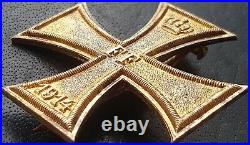
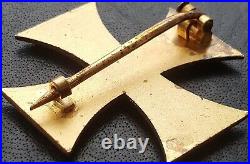
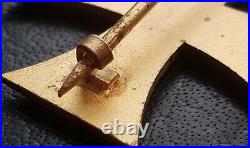
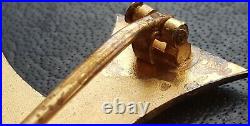
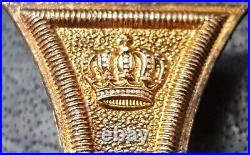
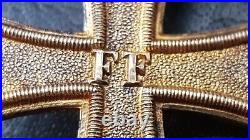
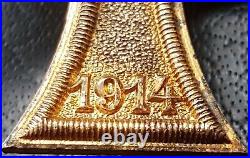
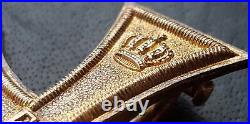
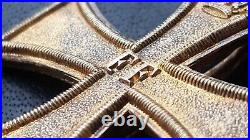
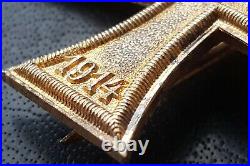
Original German post WW2 made WW1 Mecklenburg Military Merit Cross First Class (Militärverdienstkreuz) , IN VERY NICE CONDITION – POST WW2 MADE EXAMPLE / MAKER: ST&L (STEINHAUER UND LUECK) – GOOD EARLY EXAMPLE WITH SOLID HINGE BLOCK, PERFECTLY WORKING PIN DEVICE, HARD TO FIND – REALLY GOOD AND RARE PIECE. FEW FACTS ABOUT POST WW2 MADE IMPERIAL GERMAN & FOREIGN AWARDS. After WW2 wear and display of former Nazi decorations were strictly prohibited in Germany. As Germany split apart into East and West Germany, each of these new countries issued directives concerning the status of former awards and decorations of Nazi Germany. Within East Germany, these awards were all abolished with a new era of German Communist decorations created to take their place. However, in West Germany, pre 1933 issued awards were fully accepted to wear & display, therefore these awards (including foreign awards) were continuously produced after the end of the war by major manufacturers, such as Steinhauer & Lück, Deumer or Souval. In 1957 the West German government authorised replacement Iron Crosses with an Oak Leaf Cluster in place of the swastika, similar to the Iron Crosses of 1813, 1870, and 1914, which could be worn by World War II Iron Cross recipients. The 1957 law also authorised de-Nazified versions of most other World War II-era decorations (except those specifically associated with Nazi Party organizations, such as SS Long Service medals, or with the expansion of the German Reich, such as the medals for the annexation of Austria, the Sudetenland, and the Memel region). HISTORY OF THE AWARD. Mecklenburg Military Merit Cross (Militärverdienstkreuz) was established by Friedrich Franz II, Grand Duke of Mecklenburg-Schwerin on August 5, 1848. Mecklenburg-Schwerin, a grand duchy located in northern Germany, was a member of the German Confederation and later the German Empire. In several respects, Mecklenburg-Schwerin’s Military Merit Cross was patterned after the Prussian Iron Cross. Both came in two classes, a pinback 1st Class and a 2nd Class worn from a ribbon, both were awarded without regard to rank (most other orders and medals of both states were awarded in different classes based on the rank or status of the recipient), and both were awarded for specific campaigns, as indicated by a date on the bottom arm of the cross. However, there were more versions of the Mecklenburg cross than of the Prussian cross (which was only awarded by Prussia in the Napoleonic Wars, the Franco-Prussian War and World War I, and by Germany in World War II). The first versions were dated 1848 and 1849, and awarded for merit in the First War of Schleswig and in the suppression of the German Revolution of 1848-49 (some Mecklenburg troops were sent to Baden in 1849 while others remained in the fighting in Schleswig). In 1859, some Mecklenburg observers and Austrian officers were decorated for merit during the Second Italian War of Independence. The next version was dated 1864, and recognized merit in the Second War of Schleswig, also called the German-Danish War. Mecklenburg-Schwerin’s participation on the side of Prussia and other north German states in the Austro-Prussian War led to the next version, dated 1866. An 1870 version was created for the Franco-Prussian War, where Mecklenburg troops fought as part of the 17. In this war, a number of officers and soldiers received both the Iron Cross and the Mecklenburg-Schwerin Military Merit Cross. The next version was dated 1877. Certain German states, especially Mecklenburg-Schwerin, were sympathetic to the Russian and Romanian cause, and had dynastic connections to both states. Grand Duke Friedrich Franz II’s grandmother was Grand Duchess Elena Pavlovna of Russia, his daughter was married to Tsar Alexander II of Russia’s son, and his son and heir, Friedrich Franz III, would marry Grand Duchess Anastasia Mikhailovna of Russia in 1879. The Romanian royal family was a branch of the Hohenzollerns, the ruling house of Prussia and the newly created German Empire. A version dated 1900 was struck for Mecklenburgers who had distinguished themselves in the Boxer Rebellion of 1900-01. An undated version was then created, which was awarded for merit in various colonial conflicts of the first decade of the 20th century, including the Herero Wars (a series of brutal conflicts where some Germans displayed great bravery in fighting guerrillas from the Herero and other tribes, while other Germans perpetrated what has come to be seen as the genocide of the Herero people). Germany entered World War I in the first days of August 1914. On February 28, 1915, Friedrich Franz IV, Grand Duke of Mecklenburg-Schwerin, reauthorized the Military Merit Cross. The new version was dated 1914 and awards were made retroactively to the beginning of the war. Both classes of the Military Merit Cross continued to be awarded throughout the war, both to Mecklenburgers and to soldiers of other German states and German allies. Upon Friedrich Franz IV’s abdication in November 14, 1918, the Military Merit Cross became obsolete. It continued to be permitted for wear by those who had received it through the Weimar era, the Third Reich and in West Germany (it is unclear whether East Germany permitted the wear of any Imperial German decorations). In all its versions, the Mecklenburg-Schwerin Military Merit Cross was a bronze gilt cross pattée ins design, similar to the Iron Cross but with slightly narrower arms. The obverse bore a crown on the upper arm, the initials of Friedrich Franz in the center, and the date (except for the colonial version) at the bottom of the lower arm. The reverse of the 2nd Class bore the legend “Für Auszeichnung im Kriege” (“For distinction in the war”). The reverse of the 1st Class, a pinback cross (Steckkreuz), was blank. The ribbon was light blue with narrow edge stripes of yellow and red (with the red stripes on the outside). For awards to non-combatants, the same cross was worn, but the ribbon was changed to red with light blue and yellow edge stripes. This item is in the category “Collectables\Militaria\World War II (1939-1945)\Medals/ Ribbons”. The seller is “a..anderson” and is located in this country: GB. This item can be shipped worldwide.
- Country/Region of Manufacture: Germany
- Country/ Organization: Germany
- Issued/ Not-Issued: Issued
- Theme: Militaria
- Type: Medals & Ribbons
- Conflict: World War I (1914-1918)
- Service: Navy
- Era: 1914-1945
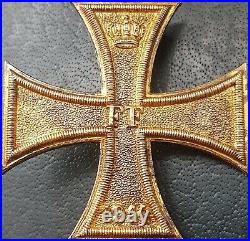
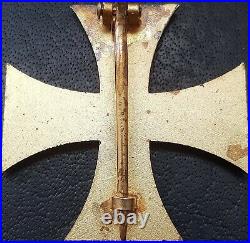
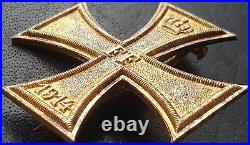
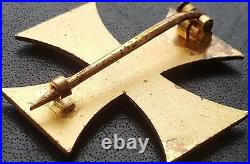
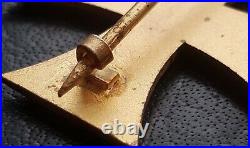
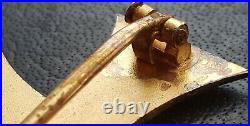
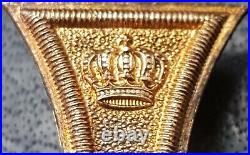
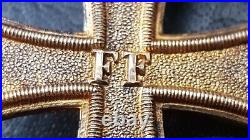
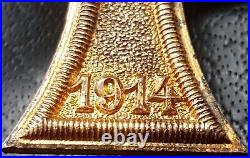
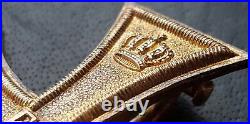
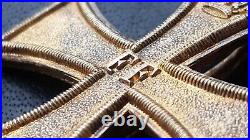
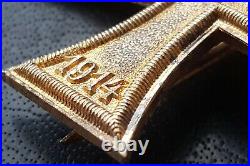
Original German post WW2 made WW1 Mecklenburg Military Merit Cross First Class (Militärverdienstkreuz) , IN VERY NICE CONDITION – POST WW2 MADE EXAMPLE / MAKER: ST&L (STEINHAUER UND LUECK) – GOOD EARLY EXAMPLE WITH SOLID HINGE BLOCK, PERFECTLY WORKING PIN DEVICE, HARD TO FIND – REALLY GOOD AND RARE PIECE. FEW FACTS ABOUT POST WW2 MADE IMPERIAL GERMAN & FOREIGN AWARDS. After WW2 wear and display of former Nazi decorations were strictly prohibited in Germany. As Germany split apart into East and West Germany, each of these new countries issued directives concerning the status of former awards and decorations of Nazi Germany. Within East Germany, these awards were all abolished with a new era of German Communist decorations created to take their place. However, in West Germany, pre 1933 issued awards were fully accepted to wear & display, therefore these awards (including foreign awards) were continuously produced after the end of the war by major manufacturers, such as Steinhauer & Lück, Deumer or Souval. In 1957 the West German government authorised replacement Iron Crosses with an Oak Leaf Cluster in place of the swastika, similar to the Iron Crosses of 1813, 1870, and 1914, which could be worn by World War II Iron Cross recipients. The 1957 law also authorised de-Nazified versions of most other World War II-era decorations (except those specifically associated with Nazi Party organizations, such as SS Long Service medals, or with the expansion of the German Reich, such as the medals for the annexation of Austria, the Sudetenland, and the Memel region). HISTORY OF THE AWARD. Mecklenburg Military Merit Cross (Militärverdienstkreuz) was established by Friedrich Franz II, Grand Duke of Mecklenburg-Schwerin on August 5, 1848. Mecklenburg-Schwerin, a grand duchy located in northern Germany, was a member of the German Confederation and later the German Empire. In several respects, Mecklenburg-Schwerin’s Military Merit Cross was patterned after the Prussian Iron Cross. Both came in two classes, a pinback 1st Class and a 2nd Class worn from a ribbon, both were awarded without regard to rank (most other orders and medals of both states were awarded in different classes based on the rank or status of the recipient), and both were awarded for specific campaigns, as indicated by a date on the bottom arm of the cross. However, there were more versions of the Mecklenburg cross than of the Prussian cross (which was only awarded by Prussia in the Napoleonic Wars, the Franco-Prussian War and World War I, and by Germany in World War II). The first versions were dated 1848 and 1849, and awarded for merit in the First War of Schleswig and in the suppression of the German Revolution of 1848-49 (some Mecklenburg troops were sent to Baden in 1849 while others remained in the fighting in Schleswig). In 1859, some Mecklenburg observers and Austrian officers were decorated for merit during the Second Italian War of Independence. The next version was dated 1864, and recognized merit in the Second War of Schleswig, also called the German-Danish War. Mecklenburg-Schwerin’s participation on the side of Prussia and other north German states in the Austro-Prussian War led to the next version, dated 1866. An 1870 version was created for the Franco-Prussian War, where Mecklenburg troops fought as part of the 17. In this war, a number of officers and soldiers received both the Iron Cross and the Mecklenburg-Schwerin Military Merit Cross. The next version was dated 1877. Certain German states, especially Mecklenburg-Schwerin, were sympathetic to the Russian and Romanian cause, and had dynastic connections to both states. Grand Duke Friedrich Franz II’s grandmother was Grand Duchess Elena Pavlovna of Russia, his daughter was married to Tsar Alexander II of Russia’s son, and his son and heir, Friedrich Franz III, would marry Grand Duchess Anastasia Mikhailovna of Russia in 1879. The Romanian royal family was a branch of the Hohenzollerns, the ruling house of Prussia and the newly created German Empire. A version dated 1900 was struck for Mecklenburgers who had distinguished themselves in the Boxer Rebellion of 1900-01. An undated version was then created, which was awarded for merit in various colonial conflicts of the first decade of the 20th century, including the Herero Wars (a series of brutal conflicts where some Germans displayed great bravery in fighting guerrillas from the Herero and other tribes, while other Germans perpetrated what has come to be seen as the genocide of the Herero people). Germany entered World War I in the first days of August 1914. On February 28, 1915, Friedrich Franz IV, Grand Duke of Mecklenburg-Schwerin, reauthorized the Military Merit Cross. The new version was dated 1914 and awards were made retroactively to the beginning of the war. Both classes of the Military Merit Cross continued to be awarded throughout the war, both to Mecklenburgers and to soldiers of other German states and German allies. Upon Friedrich Franz IV’s abdication in November 14, 1918, the Military Merit Cross became obsolete. It continued to be permitted for wear by those who had received it through the Weimar era, the Third Reich and in West Germany (it is unclear whether East Germany permitted the wear of any Imperial German decorations). In all its versions, the Mecklenburg-Schwerin Military Merit Cross was a bronze gilt cross pattée ins design, similar to the Iron Cross but with slightly narrower arms. The obverse bore a crown on the upper arm, the initials of Friedrich Franz in the center, and the date (except for the colonial version) at the bottom of the lower arm. The reverse of the 2nd Class bore the legend “Für Auszeichnung im Kriege” (“For distinction in the war”). The reverse of the 1st Class, a pinback cross (Steckkreuz), was blank. The ribbon was light blue with narrow edge stripes of yellow and red (with the red stripes on the outside). For awards to non-combatants, the same cross was worn, but the ribbon was changed to red with light blue and yellow edge stripes. This item is in the category “Collectables\Militaria\World War II (1939-1945)\Medals/ Ribbons”. The seller is “a..anderson” and is located in this country: GB. This item can be shipped worldwide.
- Country/Region of Manufacture: Germany
- Country/ Organization: Germany
- Issued/ Not-Issued: Issued
- Theme: Militaria
- Type: Medals & Ribbons
- Conflict: World War I (1914-1918)
- Service: Navy
- Era: 1914-1945
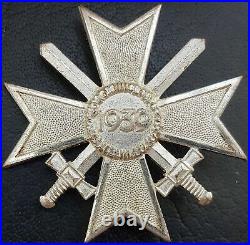
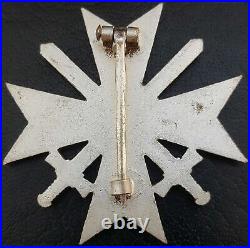
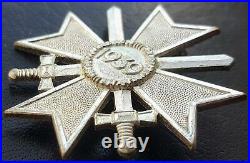
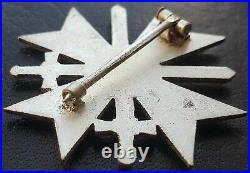
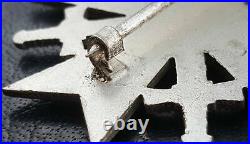
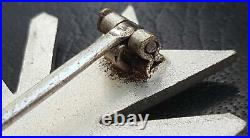
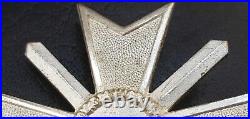
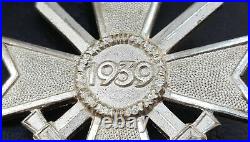
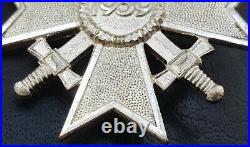
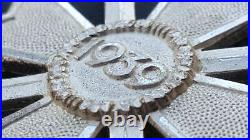
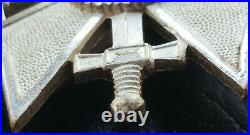
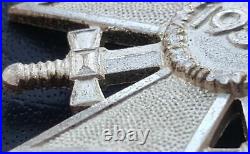
Original German War Merit Cross First Class Kriegsverdienstkreuz / post WW2 version (1957 pattern) – no swastika, IN VERY NICE CONDITION WITH PERFECT PIN DEVICE, LATER ST&L (STEINHAUER & LUECK) MADE EXAMPLE WITH OPEN HINGEBLOCK, A REALLY GOOD PIECE. FEW FACTS ABOUT THE GERMAN 1957 PATTERN AWARDS. In 1957 the West German government authorised replacement Iron Crosses with an Oak Leaf Cluster in place of the swastika, similar to the Iron Crosses of 1813, 1870, and 1914, which could be worn by World War II Iron Cross recipients. The 1957 law also authorised de-Nazified versions of most other World War II-era decorations (except those specifically associated with Nazi Party organizations, such as SS Long Service medals, or with the expansion of the German Reich, such as the medals for the annexation of Austria, the Sudetenland, and the Memel region). The main government contract to manufacture and supply these new de-nazified WW2 1957 official decorations went to the world famous German firm Steinhauer & Lueck, Luedenscheid Germany. Knights Crosses, Iron Crosses, Wound Badges, Tank Assault Badges etc were re-designed by Steinhauer & Lück – often with the oak-leaf spray replacing the swastika, with S&L having the sole patent rights to all WW2 1957 German decorations. S&L did not have the whole monopoly on medal making, other famous firms such as Deschler & Sohn, BH Maher and Juncker also manufactured these new German decorations. Lüdenscheid is situated between the cities Dortmund and Bonn. It was here that one of the youngest medal firms was founded in 1889 by August Steinhauer and Gustav Adolf Lück. The first production began in a cellar, the customer base continued to increase. A property was bought at 51 Hochstrasse which is still home for this famous company today. During WW2 Steinhauer & Lück produced medals and badges, like the famous Knights Cross and many other types of medals and badges. In 1957 this company was awarded the contract to produce all the newly re-designed legal WW2 1957 de-nazified decorations, plus the contract to manufacture all of Germany’s official decorations including Germany’s highest order the Bundesverdienstkreuz. Only a very limited number of original WW2 1957 medals are still produced, mainly Iron Crosses, German Cross Gold & Silver & Wound Badges and are considered 100% genuine by the German Government. HISTORY OF THE AWARD. The War Merit Cross (Kriegsverdienstkreuz) and War Merit Medal (Kriegsverdienstmedaille) was a decoration of Nazi Germany during the Second World War, which could be awarded to civilians as well as military personnel. It was reissued in 1957 by the Bundeswehr in a De-Nazified version for veterans. This award was created by Adolf Hitler in 1939 as a successor to the non-combatant Iron Cross which was used in earlier wars (same medal but with a different ribbon). The award was graded the same as the Iron Cross: War Merit Cross Second Class, War Merit Cross First Class, and Knights Cross of the War Merit Cross. The award had two variants: with swords given to soldiers for exceptional service in battle above and beyond the call of duty (but not worthy of an Iron Cross which was more a bravery award), and without swords for meritorious service behind the lines which could also be awarded to civilians. Recipients had to have the lower grade of the award before getting the next level. There was also another version below the 2nd class simply called the War Merit Medal (German: Kriegsverdienstmedaille), set up in 1940 for civilians in order to offset the large number of 2nd class without swords being awarded. It was usually given to those workers in factories who significantly exceeded work quotas. One notable winner of the War Merit Cross was William Joyce (aka Lord Haw-Haw) who received both the second and first class, both without swords. Recipients of the Knights Cross of the War Merit Cross customarily received the medal from holders of the Knights Cross of the Iron Cross, to symbolize the link between the combat soldier and their supporters, who helped maintain the war effort. There was one extra grade of the War Merit Cross, which was created at the suggestion of Albert Speer: The Knights Cross of the War Merit Cross in Gold, but this was never officially placed on the list of national awards as it came about in 1945 and there was no time to officially promulgate the award before the war ended. The Knights Cross of the War Merit Cross in Gold (without swords) was awarded’on paper’ to two recipients on 20 April 1945: Franz Hahne and Karl-Otto Saur. The ribbon of the War Merit Cross was in red-white-black-white-red; that was, the red and black colors being reversed from the ribbon of the World War II version of the Iron Cross. The ribbon for the War Merit Medal was similar, but with a narrow red vertical red strip in the center of the black field. Soldiers who earned the War Merit Cross 2nd Class with Swords wore a small crossed-swords device on the ribbon. The War Merit Cross 1st Class was a pin-backed medal worn on the pocket of the tunic (like the Iron Cross 1st Class). The ribbon of the War Merit Cross 2nd Class could be worn like the ribbon of the Iron Cross 2nd Class (through the third buttonhole). Combat soldiers tended to hold the War Merit Cross in low regard, referring to its wearers as being in’Iron Cross Training’, and prior to 28 September 1941, the War Merit Cross could not be worn with a corresponding grade of the Iron Cross, which took precedence. A total of 118 awards of the Knights Cross of the War Merit Cross with swords, and 137 awards of the Knights Cross of the War Merit Cross without swords were awarded. Considering the relative rarity of the award compared with the grades of the Knights Cross of the Iron Cross, it took on extra meaning. For example, Reichsmarschall Hermann Göring made a concerted effort to get Hitler to award him this order, much to Hitler’s annoyance. In response, Hitler outlined a series of criteria governing the awarding of this decoration and the philosophy of such awards, and directed that “prominent party comrades” were not to be awarded with the Knights Cross of the War Merit Cross (or similar decorations), and withdrew the proposed awards of this order to Gauleiter Erich Koch and State Secretary Karl Hanke. Directing his comments at Göring personally, Hitler ordered that such attempts to gain this award be stopped (from a letter dated 27 August 1943 from Führerhauptquartier). Also, the scarcity of the award of the Knights Cross of the War Merit Cross compared with the Kinghts Cross of the Iron Cross gave it an “air of exclusiveness” it did not really deserve, as it ranked below the Knights Cross of the Iron Cross. Six persons received two Knights Cross’ of the War Merit Cross (one with Swords and one without Swords): Walter Brugmann, Julius Dorpmuller, Karl-Otto Saur, Albin Sawatzki, Walter Schreiber, and Walter Rohlandt. This item is in the category “Collectables\Militaria\World War II (1939-1945)\Medals/ Ribbons”. The seller is “a..anderson” and is located in this country: GB. This item can be shipped worldwide.
- Era: 1945-Present
- Country/ Organization: Germany
- Country/Region of Manufacture: Germany
- Theme: Militaria
- Conflict: World War II (1939-1945)
- Service: Army
- Type: Medals & Ribbons
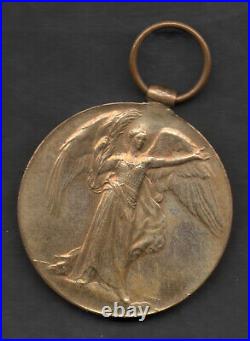
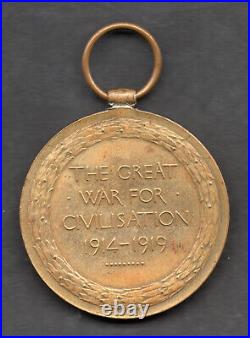
Genuine 1915 WWI first World War Medal. NAME: Walter William Johnstone. Death Date: 26th January 1915. Type of Casualty: Killesd in Action. War: Western European Theatre. All coins / banknotes are scanned at 1200 dpi resolution. The coin in the photos is the one being offered. This item is in the category “Collectables\Militaria\World War II (1939-1945)\Medals/ Ribbons”. The seller is “river_glen” and is located in this country: GB. This item can be shipped to all countries in Europe, United States, Canada, Antigua and Barbuda, Australia, Bahrain, Japan, New Zealand, China, Israel, Hong Kong, Indonesia, Malaysia, Mexico, Singapore, South Korea, Taiwan, Bangladesh, Belize, Bermuda, Bolivia, Barbados, Brunei Darussalam, Cayman Islands, Dominica, Egypt, Guadeloupe, Grenada, French Guiana, Jordan, Cambodia, Saint Kitts-Nevis, Saint Lucia, Sri Lanka, Macau, Maldives, Montserrat, Martinique, Nicaragua, Oman, Pakistan, Paraguay, Reunion, Turks and Caicos Islands, Aruba, Saudi Arabia, South Africa, United Arab Emirates, Chile, Bahamas, Colombia, Costa Rica, Dominican Republic, Guatemala, Honduras, Jamaica, Kuwait, Panama, Philippines, Qatar, El Salvador, Trinidad and Tobago.
- Country/Region of Manufacture: United Kingdom
- Country/ Organization: United Kingdom
- Type: Medals & Ribbons
- Conflict: World War I (1914-1918)
- Era: 1914-1945
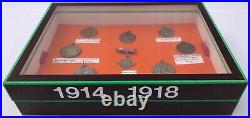
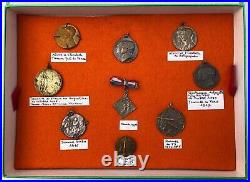
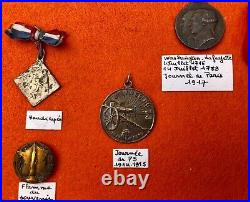
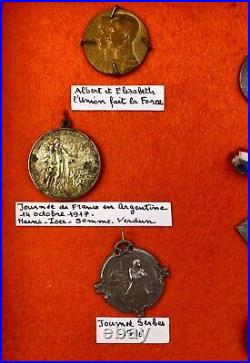
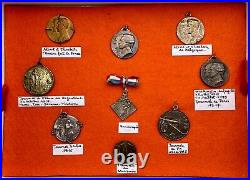
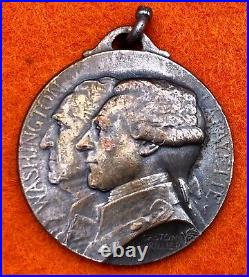
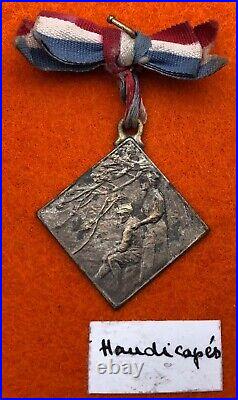
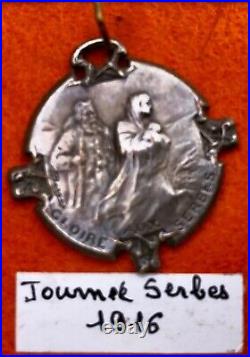
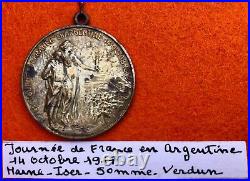
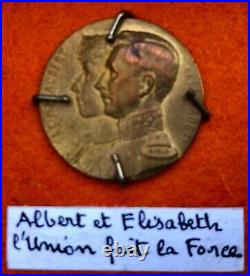
This is a unique set of first world war medals from both France and Belgium. It is an interesting decorative piece and, if with lot it LU3535310357461, it could be a nice collection set. Under each medal is a handwritten text as follows: Albert et Elisabeth, l’Union fait la force (2 different samples) signed Bargas Washington-Lafayette 4juillet 1776, Journee de Paris 1917 (2 different samples), signed Lavrillier, one on display in the Musee Carnavalet in Paris. Journee de France en Argentine 14 Octobre 1917, Marne, Iser, Somme, Verdun Hommage aux handicapes, nurse standing by a wounded soldier sitting on a chair Journees Serbes 1916 “gloire aux Serbes”, signed Bargas, one on display in the Musee Carnavalet in Paris. This item is in the category “Collectibles\Militaria\WW I (1914-18)\Original Period Items\France”. The seller is “conatus75″ and is located in this country: US. This item can be shipped to United States.
- Region of Origin: France
- Number of Pieces: 9
- Item Height: 7.5
- Country/Region of Manufacture: France
- Theme: Militaria
- Original/Reproduction: Original
- Item Width: 10.25
- Item Depth: 2.5
- Item Period: 1910-1919
- Item Style: Modern
- Conflict: WW I (1914-18)